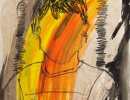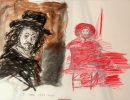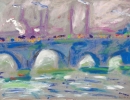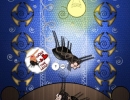




UPDATE:
For my results of using 'Tortillions & Stumps' < CLICK HERE >
———————-
Drawing peoples faces has always been a challenge for me and I am sure I am not the only one who found that I can get the shape and composition quite accurate, but when it came to shading the skin tones, well …… they end up looking about 500 years old! lol
So I discovered that IMPORTANT method people use to help get that smooth effect on the skin! (and obviously other uses that require smooth finish) – doing some research I discovered 'Tortillions' and 'Blending Stumps' some how to guides on making them.
I WILL NOT BE EXPLAINING HOW TO MAKE THEM – quite frankly I am rubbish at it, they are very cheap anyway and much better quality.
TORTILLION
This is what a Tortillion looks like:
As you can see, it is basically tightly rolled paper, with a point on the end. Mostly useful for fine details that you want to blend, smooth or soften. There really is a skill to making a tortillion, despite how easy it looks, doing this right is difficult unless you done it many times! also the type of paper makes a very big difference in the quality of your blending. The roughness or smoothness and absorbancy of the paper really matters. There is no right or wrong paper, as you can actually use papers of different type, purposely for the effect that you want. The tortillions I use I purchased on ebay fairly cheap, they are none branded but of good quality. I do not use Tortillions too often, I prefer a Blending Stump which I will discuss further down. Tortillions, I find are only really any good for one drawing then fit for the bin. But they are cheap anyway.
BLENDING STUMPS
This is what a Blending Stump looks like:
As you can see, very different but yet very similar to a Tortillion. Blending stumps are very heavily compressed paper. They last a very long time and can be used on large areas as well as small detail. I like them because they feel sturdier in the hand and last more than one use. In fact you can resharpen with fine sand paper (also done to clean them) and use them many times over. They cost about the same as Tortillions and come in many sizes. Use them on Pencil, Chalk, Crayon, tbh try them on any medium and find out! – the absorbancy is great on the ones I am using but sometimes Tortillions may be better as you can chose the paper type which you can not do with a Blending Stump.
The Blending Stumps I am using are made by Royal & Langnickel and cost less than £2.00 and been used on various drawings, no need to throw them away!
USING A TORTILLION:
It is as easy as applying you pencil marks on the page like you already do, but you then pick up the Tortillion and rub it over your pencil mark to smudge it! – apply pressure accordingly and you can control where the smudging goes. Another method of using a Tortillion or Blending Stump is to apply different grades of pencil to a scrap piece of paper like using a paint pallete and simply rub your Stump on this pallete selecting your desired grade, and then when the Blending Stump is loaded, go to the drawing and apply it where you want it. (This works best with a Stump as it is more absorbent)
This is not the best example of what a blending stump does. But will give you some idea. Left is a pencil mark left untouched. Right is a pencil mark that has been attacked with my Blending Stump 🙂
You can get some real delicate control over the blending. But I was lazy and did this as a fast quick demonstration.
I will show some examples of using them in a later post 🙂 – but now you know what I am using for shading & blending!